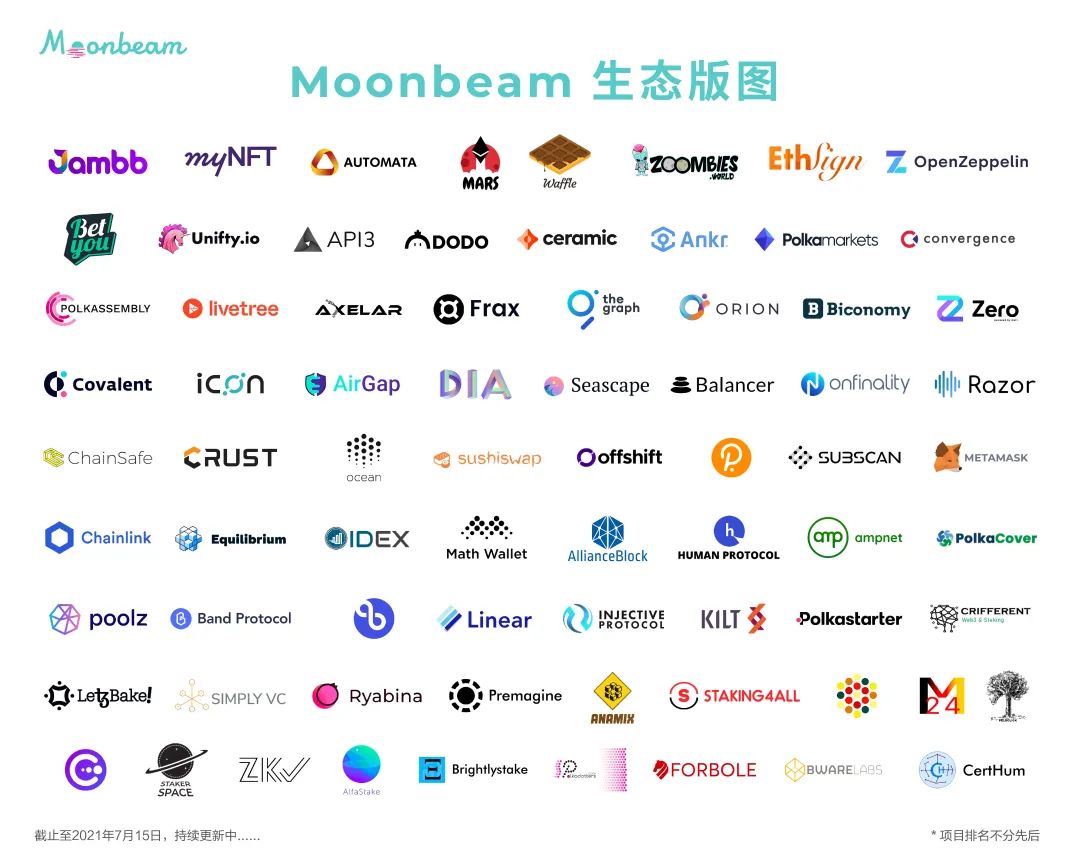The following is a recap of the content of this AMA:
Car Marz :Moonbeam is one of the most anticipated projects in 2021, and we are very happy to invite Moonbeam to participate in this AMA. First of all, please give us a brief introduction of yourself and the project.
Francisco :Hello everyone, I am Francisco Agosti, and I am the Director of Marketing and Partnerships at Moonbeam. I am mainly responsible for the development of the Moonbeam ecosystem. Before that, I worked in business development for traditional technology startups in the web2 space.
Moonbeam is an Ethereum-compatible smart contract platform for Ethereum and Solidity developers. As a parachain on the Polkadot network, Moonbeam will also benefit from the shared security of the Polkadot relay chain and connectivity to other Polkadot-related chains.
Our goal is to provide the easiest development environment and richest developer integrations on Polkadot. Through its "out-of-the-box" functions, developers can easily build on Moonbeam to attract more applications that want to try to connect to the Polkadot ecosystem to deploy.
Car Marz :We have 5 questions from Twitter users. The first question: Why is Moonbeam a highly specialized Layer 1.5 network?
Francisco :I think one of the main concepts to understand first is that we think of Polkadot as Layer 1, but in order to build on Polkadot and have an existing deployment, the team had to make some decisions.
By far the most important decision a project makes when building on Polkadot is whether to build its own parachain/parathread, or build on top of an existing parachain. Your options are:
1. Build a parallel chain: Build your own blockchain by using the Substrate development framework provided by Parity. This blockchain will be connected to the Polkadot relay chain for shared security and cross-chain communication. That's exactly what Moonbeam does.
2. Building Parathreads: Parathreads are Substrate-based runtimes that run in shared parachain slots reserved for parathreads. From a development perspective, parathreads are very similar to parachains. The key difference is that you don't pay the upfront cost of a parachain slot, but you pay for each block you want included in the chain. Therefore, there will be a market-based transaction fee model similar to how smart contract chains work. Parathreads are also similar to parachains from an implementation perspective. From a scalability and cost standpoint, they are similar to smart contracts in that they are executed in a shared environment and run like smart contracts due to deployment and ongoing transaction costs.
3. Build on top of existing parachains (such as Moonbeam): mainly in the form of building applications using smart contracts, utilizing one of the smart contract parachains connected to Polkadot. There are multiple smart contract parachain options available, supporting different smart contract programming languages.
Many teams just getting started with Polkadot are opting for a smart contract-based approach, making smart contract implementations easier, faster, and cheaper. This is ideal for teams looking to get to market quickly and prove that the product has promise in order to attract more investment. These teams have the option to migrate to full parachains if desired. In this case, they can take advantage of Polkadot's interoperability to achieve rapid migration.
Another important consideration is whether your project is considering a multi-chain deployment method. For teams pursuing a multi-chain deployment strategy, Ethereum is used as the deployment platform in most cases. Projects with existing Ethereum-based deployments will naturally gravitate toward using the smart contract approach on Polkadot and working with existing smart contract parachains.
By cooperating with parachains (such as Moonbeam), it is possible to use the same single code base for Ethereum-based deployments and Polkadot-based deployments. This is far more efficient than creating and maintaining two separate deployments of the application with two different technology stacks.
The beauty of this approach is that you can use the same tools and frameworks as Ethereum, while being able to benefit from the functionality provided by Substrate.
Car Marz :Are there any ETH projects built on Moonbeam?
Francisco :Since its inception, focusing on real application integration is the foundation of Moonbeam, not just partnership. After nearly a year of operation, Moonbeam’s test network, Moonbeam Alpha, has now integrated 150+ successful integration cases, and the number of successful cases is still increasing month by month.

The integration cases cover various segments of the blockchain, such as key DeFi tools such as oracles and AMM/DEX, NFT platforms, games and bridges. Moonriver is committed to simplifying the process of connecting to the existing Ethereum network. Developers can use Moonriver to test and verify mainstream development tools (such as MetaMask, Hardhat, Truffle, Remix and Ether.js/Web3.js), and easily achieve cross-chain compatibility. Its "out-of-the-box" functions are extremely valuable for DApp developers, which will attract more applications that want to try to link Polkadot to deploy.
We are negotiating with hundreds of projects, some of which have been tested on the Moonbeam testnet as part of their multi-chain strategy. Broadly speaking, projects fall into the following categories:
APIs: The Graph、Biconomy、Covalent、OnFinality;
Assets: Ocean Protocol, AllianceBlock, AMPnet, Poolz, Kilt, Polkastarter;
Bridges: ICON, ChainSafe, Interlay and NFT bridges under development;
DeFi: SushiSwap, Frax Finance, 0.Exchange, Balancer (via Moonbeam and Parity teams), Orion Protocol, IDEX, Linear Finance, Injective Protocol;
Oracles: Chainlink, Band Protocol, DIA, Razor.
Cooperation projects will continue to increase!
Car Marz :What is the difference between Moonbeam and other Polkadot smart contract platform (such as Astar, Clover) projects?
Francisco :Mainly specialization.
Astar offers a wide range of options, including support for the smart contract programming language ink!, the native language for Substrate and Layer 2 solutions.
Moonbeam focuses on researching and improving the Ethereum compatibility feature set, and strives to become a developer-centric platform. This includes not only adding Solidity-based smart contracts, Metamask, Truffle, Remix, Hardhat, full-featured EVM, web3 PRC and other tools, but also a unified account function, making accounts and keys on Moonbeam similar to Ethereum for easy implementation Deployment of EVM compatible projects on Moonbeam.
The Moonbeam team is working hard to build a comprehensive ecosystem, which will help generate network effects on Moonbeam, thereby expanding the ecosystem.
Another difference is that Astar provides Layer 2 solutions on its chain, while Moonbeam does not currently.
In our opinion, while Layer 2 can provide more scalability, for projects that need scalability, it is more practical to have their own parachains, so that they can fully control the implementation, and can target various use cases and will be able to benefit from the cross-chain interoperability offered as parachains, which is not as evident in Layer 2. The current state of interoperability between different Layer 2 solutions has led to market uncertainty.
Astar is a project with a strong team and we are delighted that they are part of the Kusama and Polkadot ecosystems.
I'm not that familiar with the Clover project, so I can't discuss it here.
I recommend everyone to do in-depth research before backing any project.
Car Marz :I found that there are two utility tokens $GLMR and $MOVR, can you explain the difference between these two tokens, their functions, and the market strategy?
Francisco :Glimmer (GLMR) is the utility token of the Moonbeam network, and Moonriver (MOVR) is the utility token of the Moonriver network. The basic implementation function of Moonriver is the same as that of Moonbeam, but Moonriver is a parallel chain on Kusama instead of Polkadot.
The utility of GLMR and MOVR tokens is the same as Ethereum’s ETH, which is used to pay gas fees for smart contract execution.
In addition to that, it offers additional features unique to Moonbeam/Moonriver. On the one hand, Glimmer/MOVR can be used to participate in the Moonbeam/Moonriver on-chain governance system to propose a referendum and vote on issues such as protocol upgrades. On the other hand, Glimmer/MOVR can also be staked to support collator elections and secure block production on the network.
Regarding market strategy, both networks exist independently. The relationship between Moonriver and Moonbeam is like the relationship between Kusama and Polkadot. The code of the newly launched project will be deployed to Moonriver first, and undergo a series of tests and experimental verifications in its real economic environment. After the verification is completed and passed the test, the project code can be officially deployed to Moonbeam.
Car Marz :What is the current development progress of Moonbeam? Can you please describe in detail the current development progress, market expansion plan, expected application and when will it be officially commercialized?
Francisco :The top priority this year is to continue to follow up the launch process of Moonriver on Kusama and Moonbeam on Polkadot.
For the Moonriver part, we are following the previous stage plan (for details, please refer to: Winning the slot is only the beginning|Moonriver ecological deployment is now open) to ensure the security and stability of the network. Currently in the four phases, we are in the first phase. In the fourth phase, we will open the EVM and balance transfer functions, which will open the door to project deployment and Moonriver.
We have completed a series of technical achievements unique to Moonbeam, including a parachain staking system (in addition to staking on the relay chain), which allows the community to choose collators and extend/modify the Cumulus consensus protocol without permission.
The team also added additional features to improve the developer experience, such as APIs for debugging and tracking nodes, block explorers, etc.
We're also excited about the use of precompilation. Basically it allows ethereum developers to leverage ethereum-based frameworks to use Substrate native features like staking and governance, which is going to be a really powerful feature!
secondary title
Q&A question and answer session
Question 1: How does Moonbeam engage and motivate users in the early stages of deployment?
Francisco: Our team is working on a liquidity incentive plan for future protocols that will join Moonbeam and Moonriver to accelerate the adoption/usage of these projects and users.
Question 2: Can you share with you the background of Moonbeam's core team members and how they started joining Moonbeam?
Francisco: The initial goal of the Moonbeam project is to provide a simple way to deploy applications to Polkadot by using smart contracts and an Ethereum-compatible method, thus directly challenging the problems and challenges of cross-chain interoperability.
PureStake is the company responsible for the core development of Moonbeam, led by CEO Derek Yoo. Derek and his team have extensive experience building technology companies in the Web2 space and using that experience to deliver secure, reliable services to clients.
We are all drawn together by the vision of making Moonbeam the best platform designed for developers and projects on Polkadot. If you want to know more about the team, please visit: https://www.purestake.com/about/.
Question 3: At present, NFT is very popular in the circle. Will NFT technology be applied to products in the future?
Francisco: Yes, we are working with several NFT projects to have them develop on Moonriver and Moonbeam. These include Unifty, Seascape, and myNFT, who are also currently building an NFT bridge from Ethereum to Moonbeam, which will facilitate the transfer of NFTs between the two chains.
Question 4: How important is the community to you? How can we assist or work with you to help the development of the project?
👉 Moonbeam Ambassador Program|One step at a time! Application guide taught by the current ambassador
👉 Moonbeam Ambassador Program|One step at a time! Application guide taught by the current ambassador
Question 5: Do you have a plan for Token destruction to increase the value of Token and attract investors?
Francisco: The current plan is that 20% of the transaction fees on Moonbeam and Moonriver will be transferred to the treasury, and 80% of them will be destroyed.
At the same time, we also have a model with an annual inflation rate of 5%, which will help reward collectors and pledgers and fund the foundation's future parachain slot plans.



